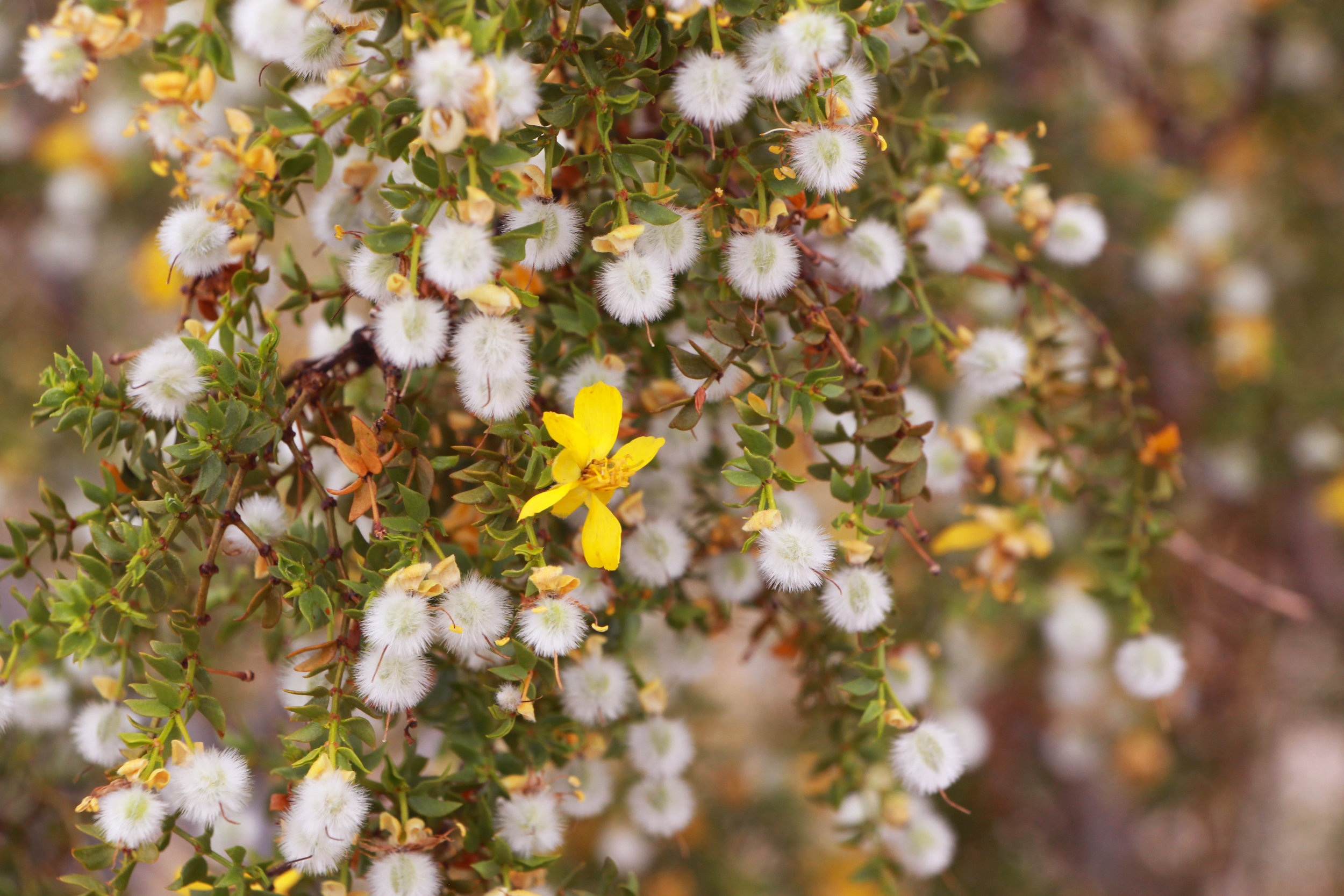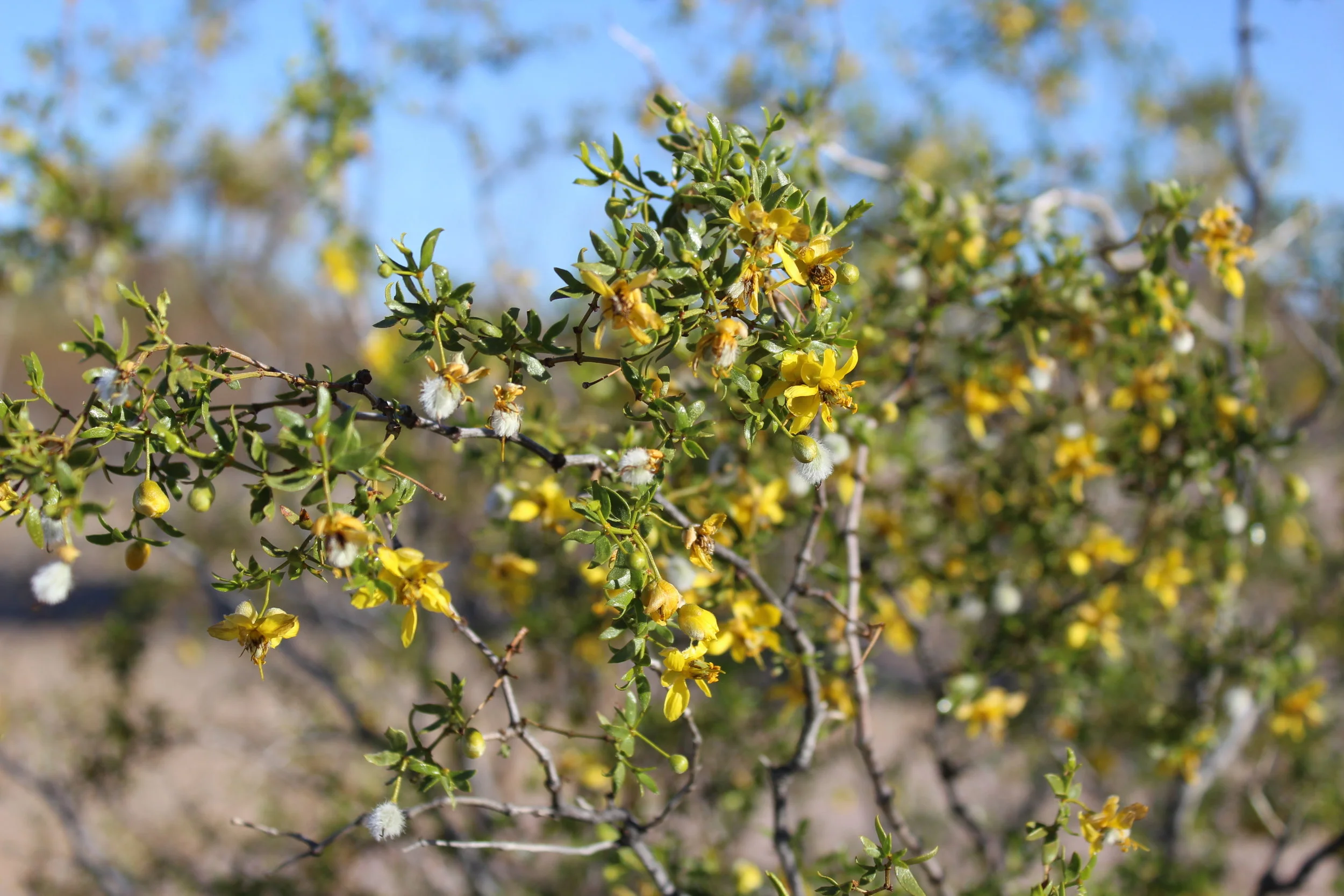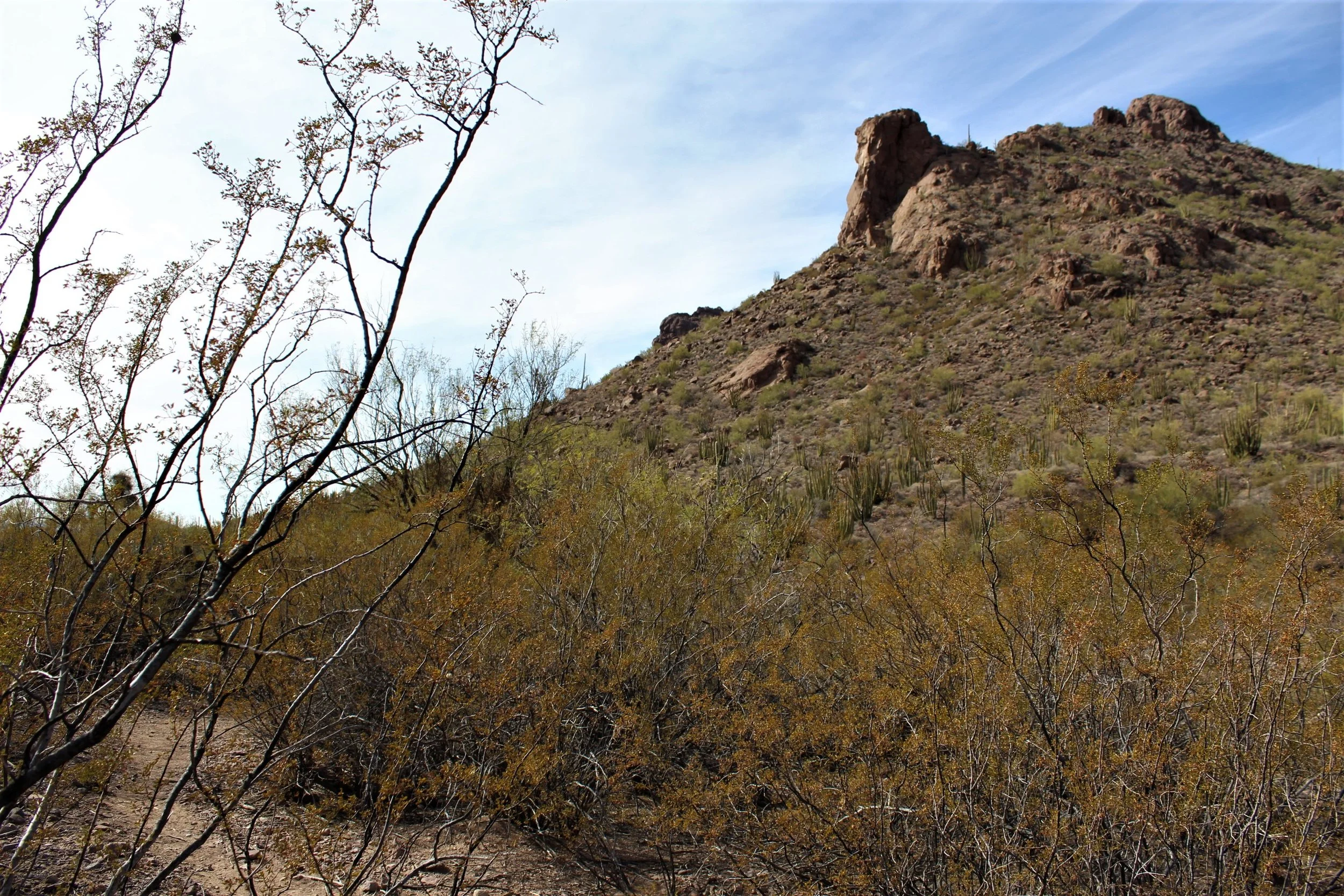Apart from the cacti, the real rockstar of my Sonoran experience was the creosote bush (Larrea tridentata). Despite having been quite familiar with creosote as an ingredient, I admit to complete ignorance of the plant from which it originates. Having no familiarity with the Sonoran Desert ecosystem, I was walking into completely new territory in regard to the flora. It didn’t take long to notice creosote though. Once we hit the outskirts of town, it seemed to be everywhere.
If you are in the Mojave, Sonoran, and Chihuahuan Deserts of western North America, you are never far from a creosote bush. They are medium sized, slow growing shrubs with sprays of compact green leaves, tiny yellow flowers, and fuzzy seeds. Apparently what is thought of as one single species is actually made up of three different genetic populations. The differences between these has everything to do with chromosome counts. Populations in the Mojave Desert have 78 chromosomes, Sonoran populations have 52 chromosomes, and Chihuahuan have 26. This may have to do with the way in which these populations have adapted to the relative amounts of rainfall each of these deserts receive throughout the year, however, it is hard to say for sure.
Regardless, creosote is supremely adapted to these xeric ecosystems. For starters, their branching architecture coupled with their tiny leaves are arranged so as to make the most out of favorable conditions. If you stare at these shrubs long enough, you may notice that their branches largely orient towards the southeast. Also, their leaves tend to be highly clustered along the branches. It is thought that this branching architecture allows the creosote to minimize water loss while maximizing photosynthesis.
Deserts aren’t hot 24 hours per day. Night and mornings are actually quite cool. By taking advantage of the morning sun as it rises in the east, creosote are able to open their stomata and commence photosynthesis during those few hours when evapotranspiration would be at its lowest. In doing so, they are able to minimize water loss to a large degree. Although their southeast orientation causes them to miss out on afternoon and evening sun to a large degree, the benefits of saving precious water far outweigh the loss to photosynthesis. The clustering of the leaves along the branches may also reduce overheating by providing their own shade. Coupled with their small size, this further reduces heat stress and water loss during the hottest parts of the day.
Creosote also secrets lots of waxy, resinous compounds. These coat the leaves and to some extent the stems, making them appear lacquered. It is thought that this also helps save water by reducing water loss through the leaf cuticle. However, the sheer diversity of compounds extracted from these shrubs suggests other functions as well. It is likely that at least some of these compounds are used in defense. One study showed that when desert woodrats eat creosote leaves, the compounds within caused the rats to lose more water through their urine and feces. They also caused a reduction in the amount of energy the rats were able to absorb from food. In other words, any mammal that regularly feeds on creosote runs the risk of both dehydration and starvation. This isn’t the only interesting interaction that creosote as with rodents either. Before we get to that, however, we first need to discuss roots.
Creosote shrubs have deep root systems that are capable of accessing soil water that more shallowly rooted plants cannot. This brings them into competition with neighboring plants in intriguing ways. When rainfall is limited, shallowly rooted species like Opuntia gain access to water before it has a chance to reach deeper creosote roots. Surprisingly this happens more often than you would think. The branching architecture of creosote is such that it tends to accumulate debris as winds blow dust around the desert landscape. As a result, the soils directly beneath creosote often contain elevated nutrients. This coupled with the added shade of the creosote canopy means that seedlings that find themselves under creosote bushes tend to do better than seedlings that germinated elsewhere. As such, creosote are considered nurse plants that actually facilitate the growth and survival of surrounding vegetation. So, if recruitment and resulting competition from vegetation can become such an issue for long term creosote survival, why then do we still so much creosote on the landscape?
The answer may lie in rodents and other burrowing animals in these desert ecosystems. Take a look at the base of a large creosote and you will often find the ground littered with burrows. Indeed, many a mammal finds the rooting zone of the creosote shrub to be a good place to dig a den. When these animals burrow under shallowly rooted desert plants, many of them nibble on and disturb the rooting zones. Over the long-term, this can be extremely detrimental for the survival of shallow rooted species. This is not the case for creosote. Its roots run so deep that most burrowing animals cannot reach them. As such, they avoid most of the damage that other plants experience. This lends to a slight survival advantage for creosote at the expense of neighboring vegetation. In this way, rodents and other burrowing animals may actually help reduce competition for the creosote.
Barring major disturbances, creosote can live a long, long time. In fact, one particular patch of creosote growing in the Mojave Desert is thought to be one of the oldest living organisms on Earth. As creosote shrubs grow, they eventually get to a point in which their main stems break and split. From there, they begin producing new stems that radiate out in a circle from the original plant. These clones can go on growing for centuries. By calculating the average growth rate of these shrubs, experts have estimated that the Mojave specimen, affectionately referred to as the “King Clone,” is somewhere around 11,700 years old!
The ring of creosote that is King Clone.
For creosote, its slow and steady wins the race. They are a backbone of North American desert ecosystems. Their structure offers shelter, their seeds offer food, and their flowers support myriad pollinators. Creosote is one shrub worthy of our respect and admiration.





